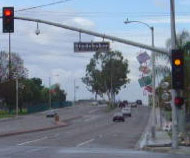11/2/2007
California: Shortened Red Light Camera Grace Nets City $2 MillionBy shortening the trigger timing on its red light cameras by 0.4 seconds, San Diego, California will collect an extra $2 million in ticket revenue.

San Diego, California will generate more than $2 million in additional revenue one year after shortening the red light camera program's "grace period" trigger settings. The staggering figure represents a ten-fold increase over the $200,000 promised during the July 2006 city council vote to shorten the timing.
The grace period reduction reflects a decrease in the amount of time allowed to a motorist before a ticket is issued and after the light changes from yellow to red. According to a 2002 audit of the San Diego program, this period ranged from 0.3 to 0.5 seconds between 1998 and 2001. The city council's sole purpose in dropping this number to a lightning-quick 0.1 seconds was to issue more citations to rescue the city budget from the "financial doldrums." In some cases, 0.1 seconds is so quick that signal heads in a red light camera photograph can display both yellow and red signals simultaneously.
In 2005, one full year before the change, San Diego issued 6783 tickets worth $2,313,003. With the timing change, the program has issued almost 9000 tickets from January to August 2007. At this rate, the city will issue $4.3 million worth of tickets this year.
The reason such a small change in timing has such great effect is that about four out of every five red light camera citations are issued before even a second had elapsed after the light changed to red, according to a report by the California State Auditor. Shorter trigger settings allow jurisdictions to collect more revenue because the greatest number of technical violations occur within the first 0.25 seconds after a light turns red, according to a Texas Transportation Institute study. Confidential San Diego documents obtained in a 2001 court trial prove that the city and its vendor, now ACS, only installed red light cameras at intersections with high volumes and an "Amber (yellow) phase less than 4 seconds." The short yellow and short grace periods have the same effect on revenue.
But the Texas suggests that issuing tickets for these technical violations has little impact on safety. The probability of a right-angle collision within a split-second after a signal changes from yellow to red is almost zero at an intersection with a protected left turn lane. "Given a 1.0-second all-red interval, the probabilities also suggest that crossing through vehicles will not start to enter until after about 4 seconds have lapsed," the Texas study explained (page 99).
San Diego Police Chief David Bejarano explained the photo ticketing program's net effect on safety during an interview with Nightline: "And it's true in a few intersections we found a few more accidents than prior to the red light photo enforcement. At some intersections we saw no change at all, and at several intersections we actually saw an increase in traffic accidents." Accidents have also not dropped under the current red light program.


